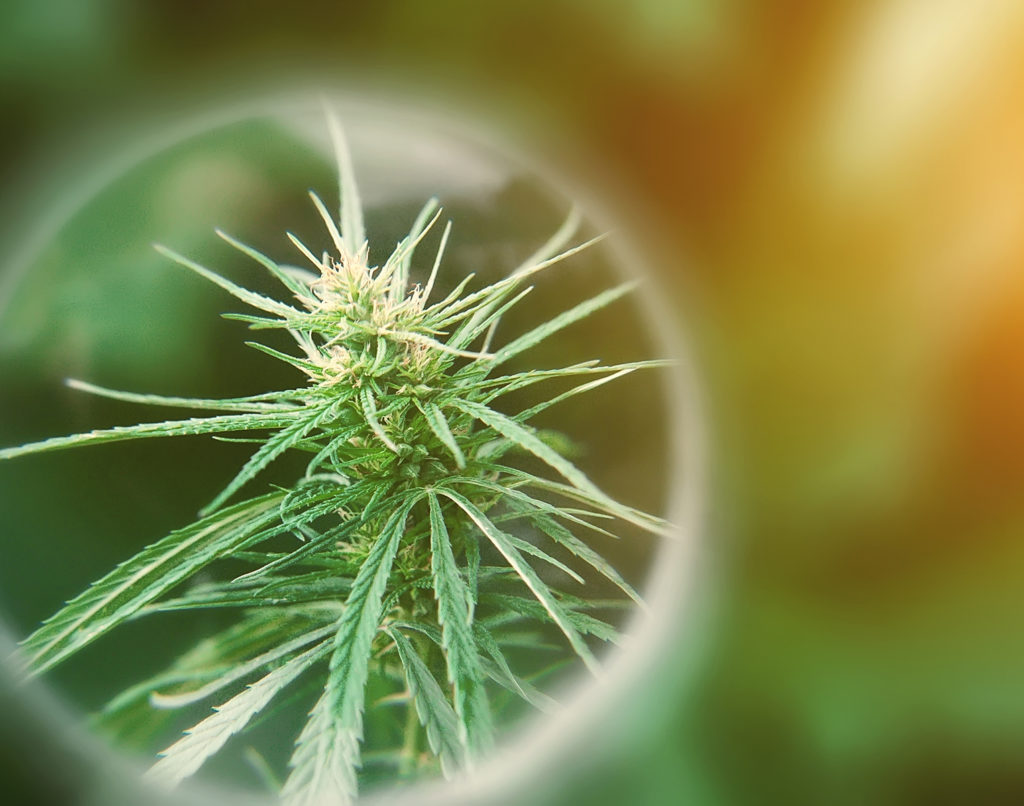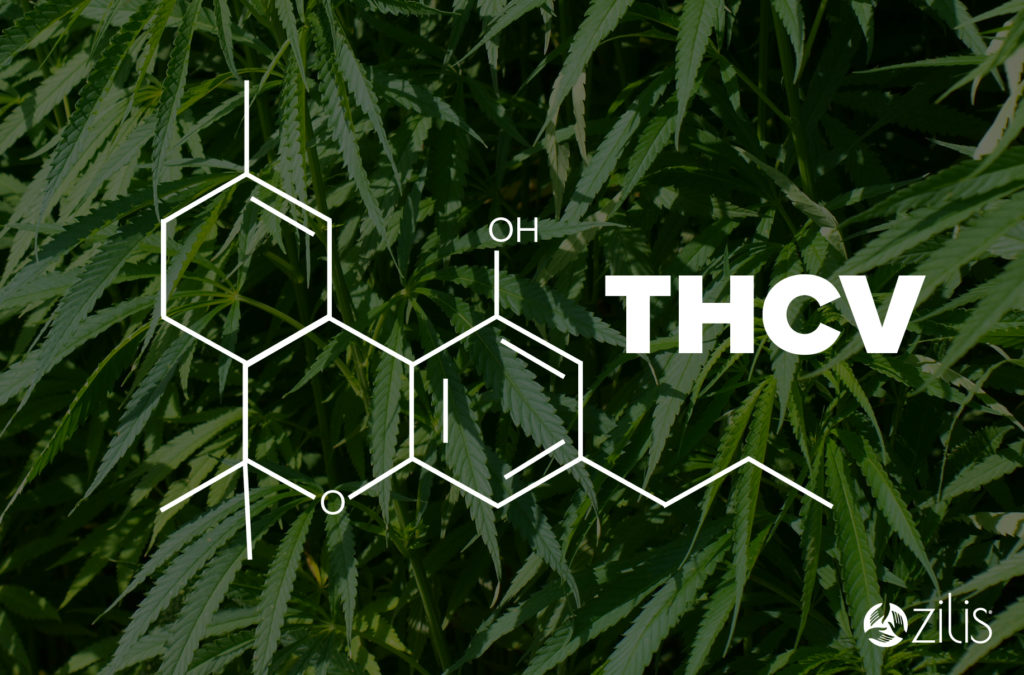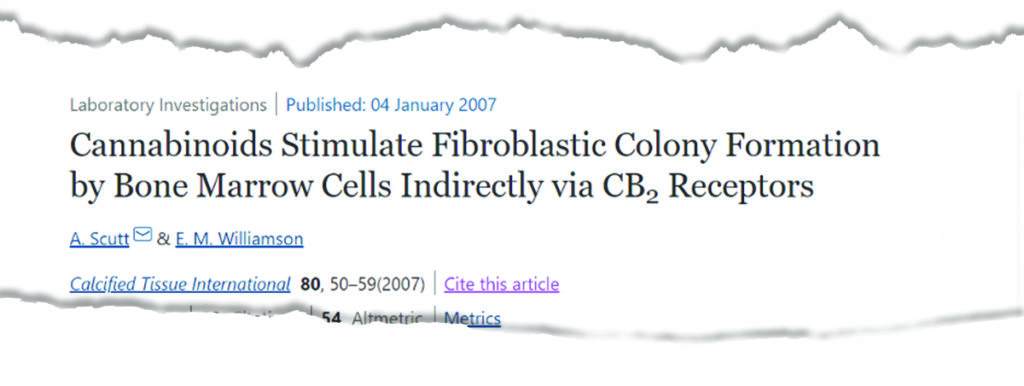
The Major Role for Minor Cannabinoids
October 21, 2020

This week we turn our attention to the “minor” cannabinoids—CBC, CBN, THCV, and CBDV (which are rapidly becoming “major.”) These four cannabinoids are experiencing a surge in popularity for numerous reasons, most notably how they differ from CBD in their engagement with our ECS and how they actively contribute to the entourage effect*. CBC, CBN, THCV, and CBDV were all roughly discovered about 50 years ago and while they are not new in the world of science, they are now emerging as the new superstar cannabinoids for the rest of us. Let’s take a look at the amazing benefits each one has to offer.
Cannabichromene (CBC)
Cannabichromene (canna-bi-chrom-een) is a derivative of cannabichromenic acid, which shares the same precursors as CBD, CBG, and THC. It was discovered in 1966 by Dr. Raphael Mechoulam, who also discovered CBD and THC. Cannabichromene is non-psychotropic and considered one of the “Big 6” in research. While it is chemical structure is similar to CBD and THC, it acts on the body in a most unique way.

Research over the years has yielded some different characteristics of CBC, making it a sort of outlier in the cannabinoid family. CBC has an affinity to bind with specialized receptors called Transient Receptor Potential Vanilloid 1 (TRPV1) and Transient Receptor Potential Akyrin 1 (TRPA1), instead of the ones we frequently hear about, CB1 and CB2. TPRV1 receptors, also known as capsaicin receptors, are responsible for nociception and heat sensations, body temperature, and detection of harmful toxins. Capsaicin is the oily compound in hot chili peppers that creates the burning sensation when you eat them, which you feel because the oily compound activated the TRVP1 receptors. TRPV1 receptors are located throughout the peripheral nervous system and were discovered to be predominately on neurons involved in detecting uncomfortable and harmful stimuli. The other receptor that CBC has an affinity for is TRPA1. These receptors are found in every cell membrane, stimulate senses, and produce tears. TRPA1 receptors are activated by sensory stimuli like itching, coughing, or cold. The interesting part about all this is when CBC activates TRPA1 and TRPV1, levels of our endocannabinoids (cannabinoids produced naturally by the body), such as anandamide, are increased. Anandamide was discovered in the early 1990’s and after studying the compound, its name was created from the Sanskrit word for bliss. Anandamide is known as the “bliss” molecule as it creates a feeling of well-being.
So, what does CBC do?
CBC, although currently recognized for its part in supporting a positive state of mind,* has begun to show promise in certain treatments as a standalone cannabinoid and as a synergistic partner to other cannabinoids. Studies show that CBC blocks nociception and high levels of inflammatory compounds* because it binds directly with receptors that regulate those sensations.1 In a 2013 study on murine brain cells2, CBC demonstrated a positive effect upon neural stem progenitor cells (NSPC) which are essential to healthy brain function. Researchers discovered the NSPCs became more viable in the presence of CBC by inhibiting these fragile cells from differentiating into a type of cell (astrocyte) that may exacerbate neurodegenerative diseases.3


Another study in 2014 suggested that because CBC appears to lead to increased levels of anandamide, it may be a potential therapy in lieu of or in addition to harsher known treatments, when abnormal cell proliferation is detected. What does that mean? It means that CBC inhibits the enzyme that breaks down anandamide which in-turn allows anandamide to stay in the bloodstream longer to be utilized by the body. Research shows that there is a link between anandamide and degrees of abnormal cell growth in certain tissues.*4 Additionally, in 2016 a study on the overactive sebaceous glands (which produce oil found in hair follicles) in the skin demonstrated that CBC promotes healthy oil production levels and may help reduce facial blemishes.*5 CBC has promise to become a novel anti-blemish agent* and tool in the management of skin irritation.* Finally, and pertinent to the new normal we are all becoming accustom to living in, CBC has also been shown to promote a positive state of mind when used in conjunction with other cannabinoids,*6 another example of synergy and the importance of the entourage effect.
Cannabinol (CBN)
The next “minor” superstar is cannabinol (cannab-i-nol). CBN in most cases is a derivative of THC but unlike THC, it is non-psychotropic. CBN partially interacts with CB1 and CB2 receptors but has a higher affinity for CB2 receptors, which are mostly found in the peripheral nervous system and immune cells. While THC binds to these receptors, CBN acts as an agonist (activates) a different type of receptor, known as the Transient Receptor Potential Vanilloid 2 (TRPV2) receptor. This means that CBN works directly on (TRPV2) receptors while only moderately interacting with the CB1 and CB2 receptors. TRPV2 receptors are known as high-threshold thermo-sensors and are known to spark therapeutic activity within the body. They are found mostly in the lungs, spleen, lymph nodes spinal cord and brain.

So, what does CBN do?
There is currently some research being conducted on CBN, but more studies are needed. One human clinical trial completed in the 1970s demonstrated properties of CBN that were thought to promote sleep.*7 Another study with promising results took place in 2008 and studied the potential of CBN to destroy resistant strains of various microorganisms.*8 Over the years more animal studies have been completed and in 2005, a murine study to better understand a severe genetic neurological condition. Researchers found treatment with CBN was associated with delayed onset of common physiological effects.9 Even though the anecdotal evidence is overwhelming, human trials must still be conducted. Research has also been conducted to determine the ability of CBN to support overall sight and eye health. In 2007, Dr. Raphael Mechoulam, lifelong cannabinoid researcher, reported detectable changes in intraocular pressure following treatment with various cannabinoid compounds, including CBN.10

Tetrahydrocannabivarin (THCV)
Another minor cannabinoid beginning to make its debut to the public is tetrahydrocannabivarin (tetra-hydro-cannabi-varin) or THCV. THCV is a derivative of its acid form, tetrahydrocannabivarinic acid (THCVa), which comes from cannabigerovarinic acid (CBGVa). Although it has a molecular structure similar to THC, THCV produces very different effects than THC, providing a more motivated, alert, energized feeling as well as being non-psychotropic like CBD and CBG.

So, what does THCV do?
Since its discovery, research on THCV has produced many promising outcomes. What appears to be the developing theme across the THCV studies is its ability to support enhanced communication, between the brain, muscles, bones, and energy systems. In addition to the supported communication THCV has demonstrated an ability to support the restoration of energy usage, such as changes in the body’s use of glucose for metabolism and other related functions.*11 One study, that focuses on THCV and the support neuro-muscular communication,* showed promise for both reduction of disease progression and relief of symptoms in a neurodegenerative and movement disorder animal model*12 Although further research is needed there have been fascinating studies completed on the relationship between THCV and healthy bone growth and its use to reduce hunger and changes in blood sugar levels.14

Cannabidivarin (CBDV)
Finally, we come to our last featured minor cannabinoid—cannabidivarin (cannab-i-di-varin) or CBDV. Like THCV, CBDV is derived from its acidic form cannabidivarinic acid, which comes from cannabigerovarinic acid. CBDV was also discovered about 50 years ago by Dr. Raphael Mechoulam. It is non-psychoactive and is also known to bind to TRPV1 and TRPA1 receptors throughout the body. CBDV has been studied more thoroughly than the other minor cannabinoids and some clinical trials are already underway.

Research focused on CBDVs role in coordination and movement can be seen in an interesting and recent study designed to better understand genetic neurodevelopmental disorders, with effects to skeletal-muscular communication. The group treated with the CBDV compound were reported to have improved general health, increased social energy, and improved movement and coordination.*15 A 2019 study from the British Journal of Pharmacology found promising possibilities of CBDV to help reduce inflammatory compounds,* support muscle function,* and improve movement* for those affected by a genetic disorder that affects the muscles.*16 Now that cannabinoids are front and center again in the public eye, further research is needed to validate these remarkable and promising benefits that these minor cannabinoids may offer.
1 DeLong, G. T., Wolf, C. E., Poklis, A., & Lichtman, A. H. (2010). Pharmacological evaluation of the natural constituent of Cannabis sativa, cannabichromene and its modulation by Δ(9)-tetrahydrocannabinol. Drug and alcohol dependence, 112(1-2), 126–133. https://doi.org/10.1016/j.drugalcdep.2010.05.019
2 Shinjyo N, Di Marzo V. The effect of cannabichromene on adult neural stem/progenitor cells. Neurochem Int. 2013 Nov;63(5):432-7. doi: 10.1016/j.neuint.2013.08.002. Epub 2013 Aug 11. PMID: 23941747.
3 Cho, I. K., Yang, B., Forest, C., Qian, L., & Chan, A. W. (2019). Amelioration of Huntington’s disease phenotype in astrocytes derived from iPSC-derived neural progenitor cells of Huntington’s disease monkeys. Plos One, 14(3). doi:10.1371/journal.pone.0214156
4 Picardi P, Ciaglia E, Proto M, Pisanti S. Anandamide inhibits breast tumor-induced angiogenesis. Transl Med UniSa. 2014 Apr 8;10:8-12. PMID: 25147760; PMCID: PMC4140423.
5 Oláh A, Markovics A, Szabó-Papp J, Szabó PT, Stott C, Zouboulis CC, Bíró T. Differential effectiveness of selected non-psychotropic phytocannabinoids on human sebocyte functions implicates their introduction in dry/seborrhoeic skin and acne treatment. Exp Dermatol. 2016 Sep;25(9):701-7. doi: 10.1111/exd.13042. Epub 2016 Jun 15. PMID: 27094344.
6 El-Alfy AT, Ivey K, Robinson K, Ahmed S, Radwan M, Slade D, Khan I, ElSohly M, Ross S. Antidepressant-like effect of delta9-tetrahydrocannabinol and other cannabinoids isolated from Cannabis sativa L. Pharmacol Biochem Behav. 2010 Jun;95(4):434-42. doi: 10.1016/j.pbb.2010.03.004. Epub 2010 Mar 21. PMID: 20332000; PMCID: PMC2866040.
7 Karniol IG, Shirakawa I, Takahashi RN, Knobel E, Musty RE. Effects of delta9-tetrahydrocannabinol and cannabinol in man. Pharmacology. 1975;13(6):502-12. doi: 10.1159/000136944. PMID: 1221432.
8 Appendino G, Gibbons S, Giana A, Pagani A, Grassi G, Stavri M, Smith E, Rahman MM. Antibacterial cannabinoids from Cannabis sativa: a structure-activity study. J Nat Prod. 2008 Aug;71(8):1427-30. doi: 10.1021/np8002673. Epub 2008 Aug 6. PMID: 18681481.
9 Weydt P, Hong S, Witting A, Möller T, Stella N, Kliot M. Cannabinol delays symptom onset in SOD1 (G93A) transgenic mice without affecting survival. Amyotroph Lateral Scler Other Motor Neuron Disord. 2005 Sep;6(3):182-4. doi: 10.1080/14660820510030149. PMID: 16183560.
10 Kogan, N. M., & Mechoulam, R. (2007). Cannabinoids in health and disease. Dialogues in clinical neuroscience, 9(4), 413–430.
11 Jadoon, K. A., Ratcliffe, S. H., Barrett, D. A., Thomas, E. L., Stott, C., Bell, J. D., . . . Tan, G. D. (2016). Efficacy and Safety of Cannabidiol and Tetrahydrocannabivarin on Glycemic and Lipid Parameters in Patients With Type 2 Diabetes: A Randomized, Double-Blind, Placebo-Controlled, Parallel Group Pilot Study. Diabetes Care, 39(10), 1777-1786. doi:10.2337/dc16-0650
12 García, C., Palomo-Garo, C., García-Arencibia, M., Ramos, J., Pertwee, R., & Fernández-Ruiz, J. (2011). Symptom-relieving and neuroprotective effects of the phytocannabinoid Δ9-THCV in animal models of Parkinson’s disease. British Journal of Pharmacology, 163(7), 1495-1506. doi:10.1111/j.1476-5381.2011.01278.x
13 Scutt, A., Williamson, E. Cannabinoids Stimulate Fibroblastic Colony Formation by Bone Marrow Cells Indirectly via CB2 Receptors. Calcif Tissue Int 80, 50–59 (2007). https://doi.org/10.1007/s00223-006-0171-7
14 Abioye, A., Ayodele, O., Marinkovic, A. et al. Δ9-Tetrahydrocannabivarin (THCV): a commentary on potential therapeutic benefit for the management of obesity and diabetes. J Cannabis Res 2, 6 (2020). https://doi.org/10.1186/s42238-020-0016-7
15 Vigli, D., Cosentino, L., Raggi, C., Laviola, G., Woolley-Roberts, M., & Filippis, B. D. (2018). Chronic treatment with the phytocannabinoid Cannabidivarin (CBDV) rescues behavioural alterations and brain atrophy in a mouse model of Rett syndrome. Neuropharmacology, 140, 121-129. doi:10.1016/j.neuropharm.2018.07.029
16 Iannotti FA, Pagano E, Moriello AS, Alvino FG, Sorrentino NC, D’Orsi L, Gazzerro E, Capasso R, De Leonibus E, De Petrocellis L, Di Marzo V. Effects of non-euphoric plant cannabinoids on muscle quality and performance of dystrophic mdx mice. Br J Pharmacol. 2019 May;176(10):1568-1584. doi: 10.1111/bph.14460. Epub 2018 Sep 9. PMID: 30074247; PMCID: PMC6487563.
About Zilis’ Scientific Research & Development Department
Our Scientific Research and Development Department is headed up by Dr. Marielle Weintraub, a hemp industry expert. She holds a master’s and a PhD in Behavioral Neuroscience and is very active in many dietary supplement and hemp industry trade associations, including her role as the current President of the U.S. Hemp Authority. Dr. Weintraub is committed to the continued development of hemp-specific information and testing to fulfill the Zilis mission.
Science posts for Discover are co-researched and co-written by Kelly McGill, Senior Scientific Technical Writer at Zilis. Kelly holds a bachelor’s degree in English and a master’s in Linguistics / TESL. She has been writing science-related content for over 20 years and is an expert in making difficult concepts easy to understand.
Zilis is the creator of UltraCell™, a CBD oil product derived from hemp. Based in Argyle, Texas, a suburb of Dallas-Fort Worth, Zilis is privately held. Visit zilis.com for more information.
SHARE THIS POST
ABOUT THIS BLOG
Discover : The blog with the lifestyle, nutrition, science, and history of the hemp industry.
It’s your go-to for the most up-to-date information on hemp, CBD, dietary supplements, and more! Check it out!







